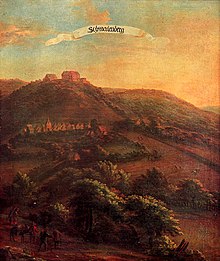Carl Ferdinand Fabritius
Carl Ferdinand Fabritius (* 1637 in Warsaw ; † January 21, 1673 in Vienna ) was a German painter who worked in Vienna, Mainz and Paderborn in the third quarter of the 17th century .
Life
Born in Warsaw in 1637, Fabritius was trained by the painter Johann Ludwig Kegl in Vienna at an early age . There he also got to know the painting collection of the Vienna Hofburg and seems to have studied it extensively. After his marriage in St. Stephen's Cathedral in 1659, he moved to Mainz, presumably through contact with the Mainz canon Theodor (Dietrich) Caspar von Fürstenberg, who stayed at the Viennese court in 1658 and 1661, to Mainz, where he also became the father of a son. Theodor Caspar's brother Ferdinand von Fürstenberg, Bishop of Paderborn, brought Fabritius to Paderborn around the turn of the year 1663/64, where he can be traced back to 1667 as a painter in the prince-bishop's castle Neuhaus. From 1670 he lived in Leopoldstadt in Vienna, where he shot himself on January 21, 1673.
Works
Fabritius' work has not yet been adequately researched - not least because it has the same name as the contemporary Dutch family of painters Fabritius . Three groups of works can be identified: Altar paintings (preserved in Paderborn, Neuhaus Castle, Warburg and Herdringen Castle near Arnsberg); History paintings (mainly in the castle in Münster, destroyed until 1945) and landscapes. They are divided into a number of ideal landscapes (Mainz, Landesmuseum; Vienna, Kunsthistorisches Museum; Attendorn, Schnellenberg Castle; private property) and - as his best-known work - a cycle of 63 vedute of locations in the prince-bishopric of Paderborn, which are in the Theological Faculty / Theodorianum are preserved in Paderborn. Most of his paintings are signed, but only the vedute, with a few exceptions, are also dated.
The vedute cycle
The landscape portraits from the Paderborn Monastery are usually the oldest representations of the cities, villages, monasteries and aristocratic residences in East Westphalia . Created between 1664 and 1667, they depict the objects in their condition after the Thirty Years' War, which is essentially almost without exception identical to that of the late Middle Ages, albeit with war damage; the wave of structural renovations began in 1666/67.
Fabritius made drawings on site, which is documented on the one hand by two self-portraits on vedute ( Warburg and Brakel ) and on the other hand is evident from the remarkable level of detail in the depictions, which is evidenced by the existing building stock. His locations for the preliminary drawings, which are still recognizable today, also show that he walked back and forth parallel to the object in a small area, in order to line up hidden details in the representations side by side in reality.
The inventory lists of the castle in Neuhaus, drawn up after the death of Ferdinand von Fürstenberg in 1683, show that the paintings did not hang tightly packed in the baroque manner, such as B. in the Vienna Hofburg or in Brussels, but that a few paintings each adorned a room, almost exclusively not in Ferdinand's private apartments, but in the generally accessible areas. That explains the very different formats, which are divided into four groups according to the narrow sides. The largest vedute is that of Paderborn with 300 × 181 cm, the smallest measure around 104 × 85 cm.
reception
Apparently, the cities depicted in particular began early to have copies made by other painters. When the Paderborn painter Ferdinand Woltemuth (Woltemate) renewed some apparently badly damaged vedute between 1782 and 1785 , he seems to have made and sold numerous copies. The vedute also served as models for book illustrations (Johann Conrad Pyrach), but above all Johann Georg Rudolphi used numerous of Fabritius' paintings for the second edition of the “ Monumenta Paderbornensia ”, a kind of regional history by Ferdinand von Fürstenberg, published in 1672 partly freely redesigned.
State of preservation
The majority of all known paintings by Fabritius that are presented to the public are in good condition. In the meantime, this also applies to the vedute cycle, whose property rights, which were due to the secularization, could be decided. This was followed by a restoration of the paintings in 2002/03, which was able to compensate in particular for the damage caused by a restoration in 1910.
Bibliography
Gehrken, Franz Joseph: Directory of the paintings transferred from Neuhaus Castle to the University House in 1803. In: Westfälische Zeitschrift 43 / II (1885), pp. 158–161.
Sigismund, Ernst: A rediscovered landscape painter. In: Repertorium für Kunstwissenschaft 28 (1905), pp. 512–515.
Pieper, Roland: The vedute of Carl Fabritius. Landscape portraits from the Paderborn Monastery at the time of Ferdinand von Fürstenberg. In: Norbert Börste, Jörg Ernesti (ed.), Prince of Peace and Good Shepherd. Ferdinand von Fürstenberg, Prince-Bishop of Paderborn and Münster (Paderborn Theological Studies, 42) Paderborn 2004, 465–487 a. Color plates.
Ernesti, Jörg: Ferdinand von Fürstenberg. Intellectual profile of a baroque prince-bishop (studies and sources on Westphalian history, 51). Paderborn (Bonifatius-Verlag) 2004.
Pieper, Roland: Carl Ferdinand Fabritius. Vedutas and altar paintings for the Paderborn prince-bishop Ferdinand von Fürstenberg, 1664–1667 (Studies and sources on Westphalian history, 55) Paderborn (Bonifatius-Verlag) 2006. (248 p., 88 p. Mostly color images).
Individual evidence
- ^ H. Dollmayr, Gustav Glück, A. Schaeffer, W. von Wartenegg: Die Gemäldegalerie: Alte Meister . Adolf Holzhausen, Vienna 1907, p. 372 .
Web links
| personal data | |
|---|---|
| SURNAME | Fabritius, Carl Ferdinand |
| BRIEF DESCRIPTION | German painter |
| DATE OF BIRTH | 1637 |
| PLACE OF BIRTH | Warsaw |
| DATE OF DEATH | January 21, 1673 |
| Place of death | Vienna |
